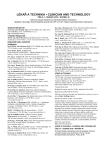TESTING A SYSTEM FOR PREDICTING MICROSLEEP
An instrument to objectively measure driver’s fatigue and to monitor approaching micro-sleep was designed, manufactured and tested. The instrument is based on a simple infrared sensor, which consists of an emitter and detector and is based on the different reflectivity of the eye and the skin of the eyelid. The instrument records eyelid activity as the number of blinks. The device has been put into practice in the form of lensless glasses and tested in an automobile simulator at the Faculty of Transport, Czech Technical University in Prague. The results show that the system was reasonably efficient at detecting fatigue, and therefore potentially micro-sleep. However, currently it is not possible to measure the effectiveness of the system and evaluate the results in real-time.
Keywords:
microsleep, prevention, infrared sensor, transportation
Autoři:
Pavel Spurný 1; Jakub Andrš 1; Peter Bouchner 2; Jiří Pučelík 1; Richard Rokyta 1
Působiště autorů:
Charles University, 3rd Faculty of Medicine, Department of Normal, Pathological and Clinical Physiology, Prague, Czech Republic
1; Czech Technical University, Faculty of Transportation Sciences, Prague, Czech Republic
2
Vyšlo v časopise:
Lékař a technika - Clinician and Technology No. 2, 2016, 46, 51-54
Kategorie:
Původní práce
Souhrn
An instrument to objectively measure driver’s fatigue and to monitor approaching micro-sleep was designed, manufactured and tested. The instrument is based on a simple infrared sensor, which consists of an emitter and detector and is based on the different reflectivity of the eye and the skin of the eyelid. The instrument records eyelid activity as the number of blinks. The device has been put into practice in the form of lensless glasses and tested in an automobile simulator at the Faculty of Transport, Czech Technical University in Prague. The results show that the system was reasonably efficient at detecting fatigue, and therefore potentially micro-sleep. However, currently it is not possible to measure the effectiveness of the system and evaluate the results in real-time.
Keywords:
microsleep, prevention, infrared sensor, transportation
Zdroje
[1] M. T. R. Peiris, R. D. Jones, P. R. Davidson, a P. J. Bones, “Detecting Behavioral Microsleeps from EEG Power Spectra”, in 28th Annual International Conference of the IEEE Engineering in Medicine and Biology Society, 2006. EMBS 2006, 5723–5726.
[2] M. Golz, D. Sommer, M. Holzbrecher, a T. Schnupp, “Detection and prediction of driver’s microsleep events”, Rese-archGate, 2009.
[3] “SmartCap Fatigue Monitoring System”. [Online]. http://smartcaptech.com/.
[4] J. Toppi, L. Astolfi, G. R. Poudel, C. R. H. Innes, F. Babiloni, a R. D. Jones, “Time-varying effective connectivity of the cortical neuroelectric activity associated with behavioural microsleeps”, NeuroImage, 124, Part A, 421–432, 2016.
[5] P. Svoboda, EEG Analysis and Classification of Microsleep on the Car Simulator (2004) - data IS VaVaI". [Online]. https://www.isvav.cz/resultDetail.do?rowId=RIV%2F68407700%3A21260%2F04%3A06104715!RIV%2F2005%2FMSM%2F212605%2FN. [09-March-2016].
[6] A. M. Malla, P. R. Davidson, P. J. Bones, R. Green, a R. D. Jones, “Automated video-based measurement of eye closure for detecting behavioral microsleep”, in 2010 Annual International Conference of the IEEE Engineering in Medicine and Biology Society (EMBC), 2010, 6741–6744.
[7] W. W. Wierwille a L. A. Ellsworth, “Evaluation of driver drowsiness by trained raters”, Accident Analysis & Prevention, 26, 5, 571–581, 1994.
[8] Peiris, Malik T. R., Richard D. Jones, Paul R. Davidson, Grant J. Carroll a Philip J. Bones. Frequent lapses of responsiveness during an extended visuomotor tracking task in non-sleep-deprived subjects. Journal of Sleep Research [online]. 2006, 15(3),291-300[cit.2016-07-22]. http://doi.wiley.com/10.1111/j.1365-2869.2006.00545.x
[9] Q. Ji a X. Yang, “Real-Time Eye, Gaze, and Face Pose Tracking for Monitoring Driver Vigilance”, Real-Time Imaging, 8, 5, 357–377, 2002.
[10] R. Rokyta, J. Pučelík, J. Dudák a A. Yamamotová. Objektivní měření únavy frekvencí mrkání. Lékař a technika: Clinician and Technology. Praha, 2013,43(3), 4. ISSN 2336-5552.
Štítky
BiomedicínaČlánok vyšiel v časopise
Lékař a technika

2016 Číslo 2
Najčítanejšie v tomto čísle
- EARLY DISCHARGE (48–72 HOURS) AFTER ACUTE ST-SEGMENT ELEVATION MYOCARDIAL INFARCTION: INTERIM RESULTS OF THE OPEN, RANDOMIZED, MONOCENTRIC STUDY
- CELL-BASED SENSOR CHIP FOR NEUROTOXICITY MEASUREMENTS IN DRINKING WATER
- TESTING A SYSTEM FOR PREDICTING MICROSLEEP
- DESIGN CONCEPTS FOR PREVENTING GAS BUBBLE INTERFERENCE IN MICROFLUIDIC DEVICES
